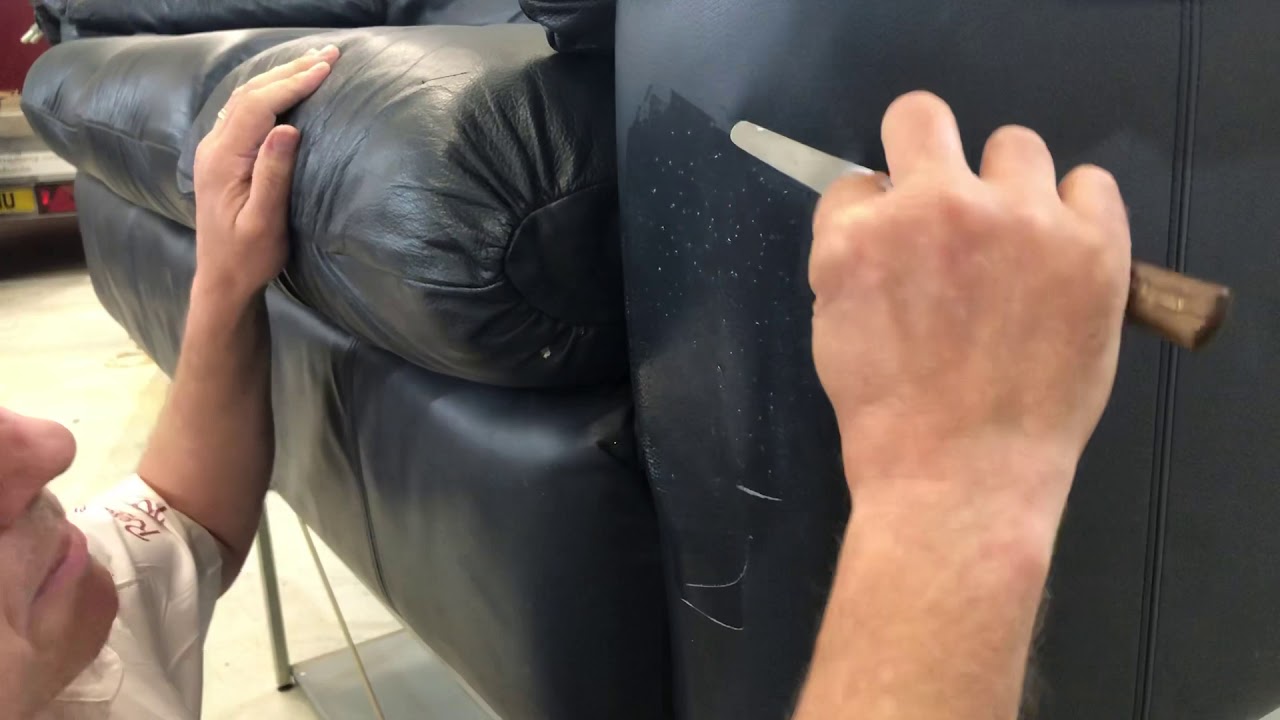How to Stop Cats from Scratching Leather Furniture

To stop cats from scratching leather furniture, use scratching posts and toys as an alternative. Are you tired of discovering scratches on your beautiful leather furniture caused by your mischievous feline friend?
Scratching is a natural behavior for cats, but it can be frustrating when they choose your expensive leather furniture as their scratching post. Fortunately, there are several effective ways to prevent this behavior and protect your furniture. We will explore some practical tips and techniques to stop cats from scratching leather furniture.
By implementing these strategies, you can enjoy both a scratch-free home and a happy cat. So, let’s dive into the solutions and bid adieu to those unsightly scratches on your leather furniture!

Credit: www.ahousewebuilt.com
Understanding The Scratching Behavior Of Cats
Understanding the scratching behavior of cats is crucial to prevent them from damaging leather furniture. Discover effective strategies and techniques to stop this behavior and safeguard your furniture investments.
Cats can be wonderful companions, but their natural instinct to scratch can cause havoc, especially when it comes to leather furniture. Understanding why cats scratch and the importance it holds for their well-being can help you find effective solutions to prevent your feline friend from turning your prized leather couch into a scratching post.
Let’s delve into the scratching behavior of cats and why they have an instinctual need to scratch.
Importance Of Understanding Cat Behavior:
- Cats scratching is a normal behavior: Scratching is an innate behavior for cats, and it serves several important purposes in their lives.
- It helps them keep their claws in good shape: Scratching helps remove the dead outer layer of their claws, keeping them healthy and sharp for various activities.
- Stretching and exercising: Scratching is a way for cats to stretch their muscles, promoting flexibility and strength. It allows them to extend their bodies to their full length and ensure their joints stay mobile.
- Territory marking: Cats have scent glands in their paws, and as they scratch, they leave a visual mark along with their scent. This territorial marking behavior helps them establish their territory and communicate with other cats.
- Emotional release: Scratching can also serve as an emotional outlet for cats, allowing them to relieve stress, frustration, and anxiety.
Why Do Cats Scratch Furniture?
Understanding why cats choose to scratch furniture instead of a designated scratching post is crucial in finding effective solutions to protect your leather furniture. Here are a few reasons why cats may prefer your leather couch:
- Texture preference: Cats have individual preferences when it comes to scratching surfaces. Leather furniture often provides a satisfying texture for them, so they are naturally drawn to it.
- Location and visibility: Cats enjoy scratching in highly visible areas to mark their territory and communicate with other cats. If your leather furniture is in a prominent location, it might be more attractive to them.
- Environmental factors: Cats may scratch furniture due to stress, boredom, or a lack of appropriate scratching options. Assessing their environment and ensuring they have access to suitable alternatives is essential.
Understanding the instinctual need for scratching can help you redirect your cat’s behavior to more appropriate outlets. In the next section, we will discuss effective strategies to prevent cats from scratching leather furniture.
Behavioral Solutions
Behavioral solutions can help to prevent cats from scratching leather furniture, ensuring your valuable pieces stay intact. By providing alternative scratching surfaces, like scratching posts or cardboard scratchers, and using deterrents like double-sided tape or citrus-scented sprays, you can redirect your cat’s natural scratching behavior and protect your furniture.
Cats scratching leather furniture can be a frustrating issue for many pet owners. However, there are several behavioral solutions that can help redirect your cat’s scratching behavior away from your beloved leather couch. By providing scratching alternatives, choosing the right scratching posts, strategically placing them, ensuring their appeal, and utilizing deterrents, you can discourage your cat from scratching your leather furniture.
Providing Scratching Alternatives
- Offer multiple scratching options throughout your home.
- Consider providing a variety of textures, such as carpeted, sisal, or cardboard scratchers.
- Experiment with different shapes and sizes to find what your cat prefers.
- Place scratching alternatives in areas where your cat frequently seeks to scratch.
Choosing The Right Scratching Posts
When selecting a scratching post for your cat, keep the following factors in mind:
- Height and stability: Choose a scratching post that is tall enough for your cat to fully extend its body while scratching, and ensure it is stable enough to support your cat’s weight.
- Material: Opt for posts made of materials that mimic the texture of your furniture, such as sisal or rough fabric.
- Sturdy base: Make sure the scratching post has a wide and sturdy base to prevent tipping over.
Placing Scratching Posts Strategically
To encourage your cat to use the scratching post instead of your leather furniture, consider the following tips for placement:
- Put scratching posts near the areas your cat tends to scratch, such as near doorways or in their preferred lounging spots.
- Position the posts in prominent areas of the home where your cat spends the most time.
- Avoid hiding the scratching post in a corner or behind furniture, as this may deter your cat from using it.
Ensuring The Scratching Post Is Appealing
To make the scratching post more attractive to your cat, you can:
- Use catnip: Rubbing some catnip on the scratching post can entice your cat to investigate and use it.
- Incorporate treats and rewards: Reward your cat with treats or praise when they use the scratching post correctly.
- Provide comfortable lounging spots nearby: Place a cozy bed or blanket near the scratching post to create a comfortable environment for your cat.
Utilizing Deterrents
Deterrents can be used to discourage your cat from scratching your leather furniture. Here are a few options:
- Citrus scents and sprays: Cats dislike the smell of citrus, so using citrus-scented products or sprays near your furniture can deter them from scratching.
- Double-sided tape: Applying double-sided tape to the areas you want to protect can discourage your cat from scratching, as they dislike the sticky feeling on their paws.
- Aluminum foil: The sound and texture of aluminum foil can be off-putting to cats, so wrapping it around the targeted furniture areas can be effective.
- Scented spray deterrents: Certain scents, such as lavender or eucalyptus, can be unpleasant for cats. Spraying these scents around your furniture may discourage scratching.
By implementing these behavioral solutions, you can effectively redirect your cat’s scratching behavior away from your leather furniture. Providing appealing alternatives, strategically placing scratching posts, and utilizing deterrents can help preserve the condition of your furniture while keeping your feline companion happy and entertained.
Environmental Modifications
To prevent cats from scratching leather furniture, environmental modifications can be made. Provide a variety of scratching posts or boards made from materials that are more attractive to cats, such as sisal or cardboard. Apply double-sided tape or aluminum foil to furniture surfaces, as cats dislike the texture, or use citrus-scented sprays as a natural deterrent.
Additionally, keeping the cats’ nails trimmed and providing plenty of toys and mental stimulation can help redirect their scratching behavior.
Furniture Coverings:
Sometimes, preventing cats from scratching your leather furniture may require some environmental modifications. Here are some options to consider:
- Using slipcovers or throws: One way to protect your leather furniture is by using slipcovers or throws. These can provide an extra layer of protection against your cat’s claws. Plus, they can be easily removed and cleaned when needed.
- Protective furniture covers: Investing in a protective cover specifically designed for furniture can be an effective solution. These covers are usually made from durable materials that can withstand scratching. They offer full coverage, ensuring your leather furniture remains unharmed.
- Protective coverings for specific areas: If your cat tends to scratch specific areas, such as the arms or corners of your furniture, you can use protective coverings designed specifically for those areas. These coverings are easy to attach and remove, providing targeted protection where it’s needed.
- Utilizing cat-friendly tapestries: Another option to consider is covering your leather furniture with cat-friendly tapestries. Cats often prefer to scratch certain textures, and by providing them with an acceptable alternative, you can redirect their scratching behavior away from your leather furniture.
- Furniture corner guards: Cats love to scratch the corners of furniture, which can be particularly damaging to leather materials. Applying furniture corner guards can help protect these vulnerable areas from scratches and keep your leather furniture looking pristine.
- Clear vinyl protectors: Clear vinyl protectors can be attached directly to your leather furniture, offering a transparent shield against scratching. These protectors are often invisible to the eye and do not compromise the aesthetics of your furniture.
By implementing these environmental modifications and providing alternative scratching options for your cat, you can effectively deter them from scratching your leather furniture and maintain a scratch-free home environment.
Training Techniques To Stop Scratching
Learn effective training techniques to stop cats from scratching leather furniture. These methods will help you redirect their natural instincts and protect your cherished belongings.
Positive Reinforcement Training
- One effective technique to stop cats from scratching leather furniture is positive reinforcement training.
- Reward your cat with treats and praise whenever they exhibit desired behavior, such as using a scratching post instead of the furniture.
- By associating scratching the post with positive experiences, your cat will be more inclined to use it instead of your leather furniture.
- Be consistent and patient with this training method, as it may take some time for your cat to fully understand and adopt the desired behavior.
- Use a clicker to further reinforce the connection between scratching the appropriate surface and receiving a reward.
Deterrent Training
- Another approach to prevent cats from scratching leather furniture is deterrent training.
- Use noise deterrents to discourage your cat from scratching the furniture. For example:
- Place double-sided tape or aluminum foil on the furniture’s surfaces that your cat frequently scratches. The unpleasant texture will discourage them from scratching there.
- Apply a cat-safe deterrent spray, such as a citrus spray, on the furniture. Cats dislike the scent, making them less likely to scratch it.
- Spray water near your cat, not directly on them, as a deterrent when they attempt to scratch the furniture.
- Consider utilizing motion-activated devices that emit a loud noise or a burst of air when the cat gets near the furniture. This helps create an association between the sound and the undesired behavior, deterring them from scratching.
Remember, the key to successful training is consistency and positive reinforcement. Using a combination of these techniques will help redirect your cat’s scratching behavior away from your leather furniture, promoting a happier and scratch-free household environment.
Cat Repellents And Attractants
Discover effective cat repellents and attractants to prevent your feline companion from scratching your leather furniture. Say goodbye to scratched surfaces with these practical solutions.
Cats can be notorious for scratching leather furniture, leaving unsightly marks and damage. However, there are effective ways to deter them from using your cherished pieces as scratching posts. By using cat repellents and attractants, you can redirect your feline friends’ attention and protect your leather furniture.
Here are some helpful methods:
Essential Oils And Scents To Repel Cats:
- Lemon oil: Apply a few drops of lemon oil on a cotton ball and place it near the furniture. The strong citrus scent repels cats and discourages them from scratching.
- Rosemary oil: Cats dislike the scent of rosemary. Mix a few drops with water in a spray bottle and spritz it on the areas your cat tends to scratch.
- Lavender oil: Known for its calming properties, lavender oil is also a natural cat repellent. Dab a cotton ball with a few drops of lavender oil and place it strategically near the furniture.
Using Catnip And Other Attractants:
- Catnip: Catnip is a herb that can attract cats and redirect their scratching behavior. Rub catnip leaves or sprinkle dried catnip on a scratching post to entice your cat to use it instead of your furniture.
- Valerian root: Similar to catnip, valerian root has a strong scent that captivates cats. Apply it to the desired scratching area to encourage your cat to direct its attention there.
Natural Deterrents Like Vinegar And Citrus:
- Vinegar: Fill a spray bottle with equal parts water and white vinegar. Spray this solution on the areas your cat often scratches. The strong smell of vinegar will discourage your cat from returning to those spots.
- Citrus: Cats generally dislike the smell of citrus fruits. Rub citrus peels onto the furniture or use a citrus-scented spray to deter your cat from scratching.
By utilizing these cat repellents and attractants, you can effectively protect your leather furniture from your furry friends’ instinctive scratching behavior. Remember to be consistent with their application and provide alternative scratching options to redirect their attention.
Protecting Leather Furniture
Prevent cats from scratching your leather furniture with these simple tips. Use deterrent sprays, provide alternative scratching surfaces, trim their nails regularly, and use protective coverings.
Regular Cleaning And Maintenance:
- Regularly clean your leather furniture with a soft cloth or vacuum cleaner to remove dust and debris.
- Use a mild soap or leather cleaner specifically designed for leather furniture.
- Gently wipe the surface of the furniture using a circular motion to avoid damaging the leather.
- Avoid using harsh chemicals or excessive water, as they can lead to discoloration or damage.
- Follow the manufacturer’s instructions for cleaning and maintenance.
Using Leather Cleaners And Conditioners:
- Apply a high-quality leather cleaner to the furniture, following the product instructions.
- Use a clean cloth to gently rub the cleaner onto the leather in a circular motion.
- Remove any excess cleaner with a dry, clean cloth.
- Apply a leather conditioner to keep the leather moisturized and prevent it from drying out or cracking.
- Follow the manufacturer’s instructions for using leather cleaners and conditioners.
Cleaning Up Scratches And Scuffs Promptly:
- For minor scratches, gently rub the scratched area with a clean, soft cloth or your fingers to blend and buff the scratch.
- If the scratch is deeper or more noticeable, use a leather touch-up pen that matches the color of your furniture. Apply the pen’s ink to the scratch and wipe away any excess.
- For scuffs, use a leather eraser or a damp cloth to gently rub the scuffed area until the mark disappears.
- Avoid using abrasive materials or excessive force that can further damage the leather.
Restoring The Appearance Of Scratched Leather:
- Use a leather repair kit that includes a color-matching compound, grain paper, and a filler.
- Clean the scratched area and dry it thoroughly before applying the repair compound.
- Apply the compound to the scratch, filling it evenly and following the kit instructions.
- Use the grain paper to imitate the leather grain pattern, giving the repaired area a natural look.
- Allow the repair compound to dry and then apply a leather conditioner to the entire furniture piece for even coloration.
Utilizing Leather Repair Kits:
- Purchase a leather repair kit that matches the color of your furniture.
- Follow the kit’s instructions carefully, as each kit may have different application methods.
- Clean the damaged area before applying any repair compounds.
- Use the provided tools and materials to repair scratches, holes, or other damages.
- Apply the finishing touches, such as color matching, grain pattern reverting, and conditioning, as directed by the kit.
Seeking Professional Restoration Services:
- If the damage to your leather furniture is extensive or you’re unsure about repairing it yourself, consider professional restoration services.
- Research and find reputable companies or individuals specializing in leather furniture restoration.
- Check reviews and ratings to ensure their expertise and customer satisfaction.
- Contact and consult with the professionals to assess the damage and discuss the best restoration options.
- Trust the professionals to restore your leather furniture to its original beauty and elegance.
Remember, taking proactive measures like regular cleaning, utilizing leather cleaners and conditioners, and promptly addressing scratches and scuffs can help protect your leather furniture from further damage and maintain its appearance for years to come.
Anti-Scratch Solutions For Leather Furniture
Protect your leather furniture from cat scratches with these effective anti-scratch solutions. Keep your furniture looking new and prevent damage with simple and practical techniques.
Leather furniture is not only elegant but also durable. However, if you have a mischievous cat, you may find yourself dealing with unsightly scratches on your prized leather sofa or chair. Thankfully, there are several effective anti-scratch solutions available to protect your leather furniture and keep it looking its best.
Here are some options to consider:
Leather Furniture Covers
- Placing a cover over your leather furniture is a simple yet effective way to safeguard it from scratches caused by your feline friend.
- Opt for covers made from durable materials like microfiber or cotton, ensuring they protect your leather furniture without compromising its aesthetic appeal.
- Ensure that the cover fits snugly over the furniture to prevent it from sliding and exposing vulnerable areas.
- Regularly wash the cover to keep it clean and free from any cat hair or allergens.
Vinyl Protectors For Leather Surfaces
- Vinyl protectors provide an extra layer of defense against scratching and can be conveniently attached to your leather furniture.
- Choose vinyl protectors that are specifically designed for leather surfaces to ensure optimal protection and compatibility.
- Measure your furniture accurately to select the right size of vinyl protector to cover the areas most susceptible to scratches.
- Easy to clean and maintain, vinyl protectors can considerably extend the lifespan of your leather furniture.
Applying Specialized Leather Protectants
- Leather protectants are specially formulated products designed to enhance the longevity of your leather furniture and shield it from scratching.
- Before applying any leather protectants, make sure to thoroughly clean the furniture to remove any dirt, dust, or stains.
- Follow the instructions provided by the manufacturer and apply the protectant evenly across the entire surface of the leather.
- Regularly reapply the protectant to maintain its effectiveness, especially in high-traffic areas or where your cat tends to scratch the most.
These anti-scratch solutions offer practical ways to safeguard your leather furniture from your cat’s playful claws. By choosing the right option that fits your needs, you can enjoy both stylish furniture and a scratch-free home environment. Remember to regularly assess the condition of your furniture and reapply protectants or replace covers as needed to ensure continuous protection.
Frequently Asked Questions Of How To Stop Cats From Scratching Leather Furniture
How Can I Prevent Cats From Scratching My Leather Furniture?
To prevent cats from scratching your leather furniture, you can provide them with alternative scratching surfaces like scratching posts or boards. Applying double-sided tape or aluminum foil to the furniture can also deter them. Regularly trimming their nails and using deterrent sprays can be effective as well.
What Are Some Natural Ways To Stop Cats From Scratching Leather Furniture?
To deter cats from scratching leather furniture naturally, you can use citrus scents like lemon or orange, as cats dislike these smells. You can also try using essential oils like lavender or eucalyptus, diluted with water, and spraying them on the furniture.
Placing aluminum foil or a cat-repellent spray can also help.
Should I Declaw My Cat To Prevent Scratching On Leather Furniture?
Declawing a cat is not recommended as it is a painful and permanent procedure. Instead, opt for humane alternatives like providing scratching posts, trimming their nails regularly, or using deterrents to prevent scratching on leather furniture. There are also soft nail covers available that can be applied to your cat’s nails.
Conclusion
To prevent your cats from scratching your leather furniture, it’s important to employ both proactive and reactive strategies. Firstly, provide your feline friends with plenty of appropriate scratching alternatives like scratching posts or boards. Place these near the furniture they tend to target.
Secondly, make the furniture less appealing by using deterrents like double-sided tape or aluminum foil. Additionally, you can try using a spray deterrent specially formulated for cats. Consistency is key when implementing these strategies, as it may take some time for your cats to fully adopt new behaviors.
Remember, punishment is not effective in changing their behavior, so always opt for positive reinforcement instead. Lastly, if scratching persists, consider trimming your cats’ nails regularly or using nail caps. By following these tips, you can protect your leather furniture while ensuring your cats stay happy and healthy.
So, go ahead and transform your home into a peaceful coexistence between your cats and your beloved furniture!










